Election
How much do elections impact the stock market and portfolio returns? Should elections even matter to long-term investors in the first place? These are the questions investors and financial professionals are facing as we approach November 5.
To provide answers, we’ve analyzed more than 90 years of market and election data and identified five ways that elections influence stock returns and investor behaviour.
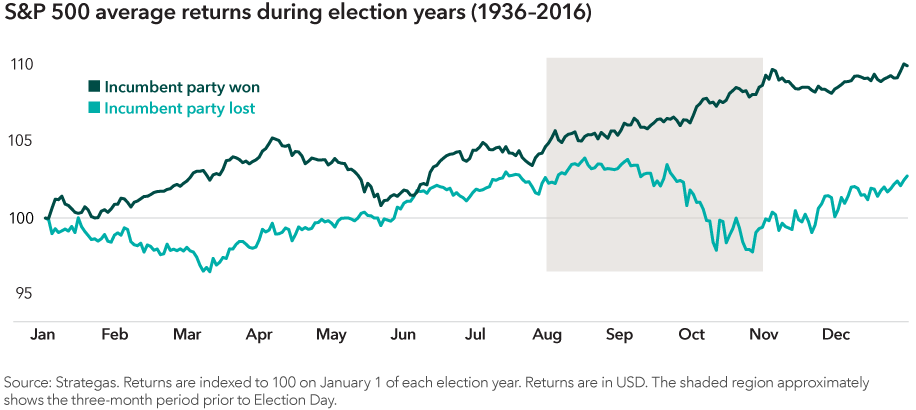
1. Markets have trended higher regardless of which party wins the election
Politics can bring out strong emotions and biases, but investors would be wise to tune out the noise and focus on the long term. That’s because elections have, historically speaking, made almost no difference when it comes to long-term investment returns.
Which party is in power hasn’t made a meaningful difference to stocks either. Since 1933, there have been eight Democratic and seven Republican presidents, and the general direction of the market has always been up. What should matter more to investors than election results is staying invested.
What does this mean for 2024? Some may feel that the 2024 election is the most important in recent memory. But that has been said about previous elections and will likely be repeated about future elections. While this year has been unique in countless ways, a look at past election cycles shows that controversy and uncertainty have surrounded many elections. And in each case the market continued to be resilient. By maintaining a long-term focus, investors can position themselves for a brighter future regardless of the outcome.
2. Gridlock or sweep? Equities have gone up either way
The presidential election isn’t the only one to watch. The results of key legislative races could determine whether either party controls both chambers of Congress, making it easier to fulfill their policy agenda. Investors often fear such “red wave” or “blue wave” scenarios, but assuming such an outcome will lead to meaningfully lower stock prices oversimplifies the complexities of stock markets.
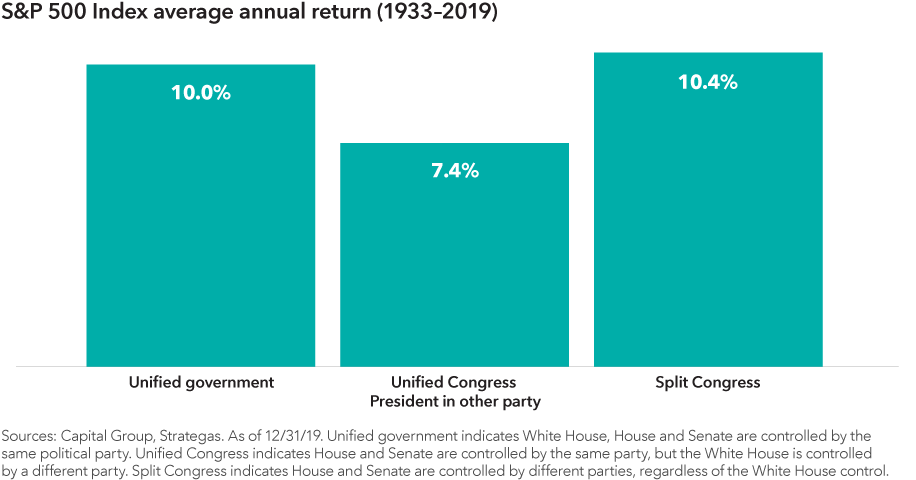
History shows that stocks have done well regardless of the political makeup of Washington. Since 1933, there have been 44 years when one party has controlled both the White House and Congress at the same time. During these periods, stocks averaged a robust 14.4% return in U.S. dollar terms, slightly higher than the average gains when Congress was split between the two parties. Historically the “least good” outcome has been when Congress is controlled by the party opposite the president, but even this scenario averaged double-digit returns.
What does this mean for 2024? Many election watchers expect the Senate to flip to Republican control in November. But narrow margins in both chambers of Congress and shifting polls for the general election mean any outcome is still possible. Voters may have a strong preference for these results, but investors should take comfort that all of these scenarios have historically produced strong equity returns.
3. Markets have tended to predict election results
A simple stock market metric has correctly predicted the winner in 20 of the last 24 presidential elections since 1936 — a track record that might make even the top pollsters jealous. If the S&P 500 Index is up in the three months prior to Election Day, the incumbent party usually wins. If markets are down during that period, the opposing party typically claims victory.
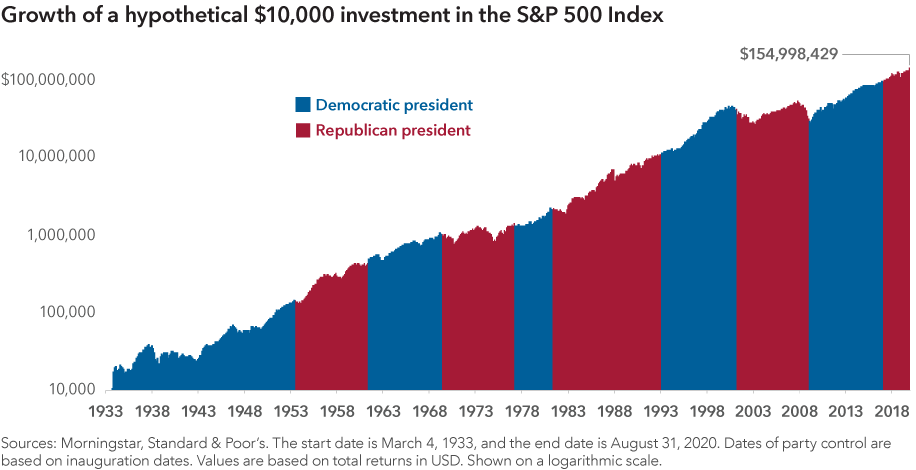
Why is this? It’s because equities tend to look ahead and “price in” uncertainty — including that caused by an upcoming election.
When the stock market and the economy are strong, there is usually less motivation for a change in leadership. In those years, stocks may not need to discount the uncertainty, which often allows stocks to continue rising, further bolstering the incumbent’s chance of reelection.
When the political and economic climate are more challenging, there is a greater chance that the opposing party will win. The market discounts the added uncertainty of the election outcome and what policy changes may occur, which can lead to higher volatility.
What does this mean for 2024? The S&P 500 Index has risen 18% this year (through July 11), and U.S. GDP has been positive for seven consecutive quarters. A strong economic and market environment typically benefits incumbent candidates. However, higher volatility in the months ahead may occur as voters wrestle with a contentious campaign. Although it will be interesting to watch how stocks move leading up to the election, investors shouldn’t use it as a reason to try to time markets. Historically, whether the incumbent wins or loses, election volatility has usually been short-lived and quickly given way to upward moving markets.
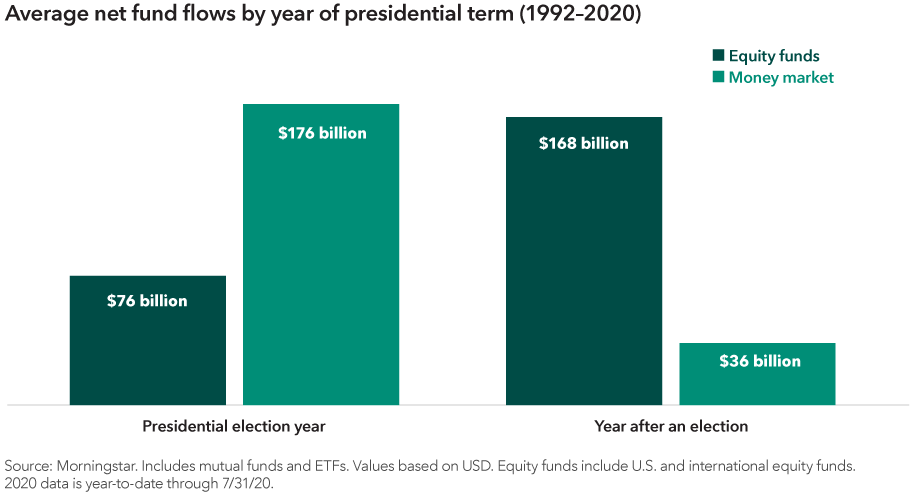
4. Investors often become more conservative in election years
It can be tough to avoid the negative messaging around election coverage. And it’s natural to allow the rhetoric of political campaigns to make us emotional. History has shown that elections have had a clear impact on investor behaviour, but it’s important that investors don’t allow pessimism to steer them from their long-term investment plans.
Investors have poured assets into money market funds — traditionally one of the lowest risk investment vehicles — to a much greater degree in election years. By contrast, equity funds have seen the highest net inflows in the year immediately following an election.
This suggests that investors want to minimize risk during election years and wait until uncertainty subsides to revisit riskier assets like stocks. But market timing is rarely a winning investment strategy, and it can pose a major problem for portfolio returns.
What does this mean for 2024? Net money market flows soared US$971 billion last year while equity flows were relatively flat. This pushed money market fund assets to record levels — US$6.1 trillion as of July 10, 2024, according to the Investment Company Institute. At these levels, many investors’ portfolios have likely become misaligned with their long-term goals. Speaking with a financial professional can be helpful to ensure portfolios are well-diversified and in line with investment objectives.
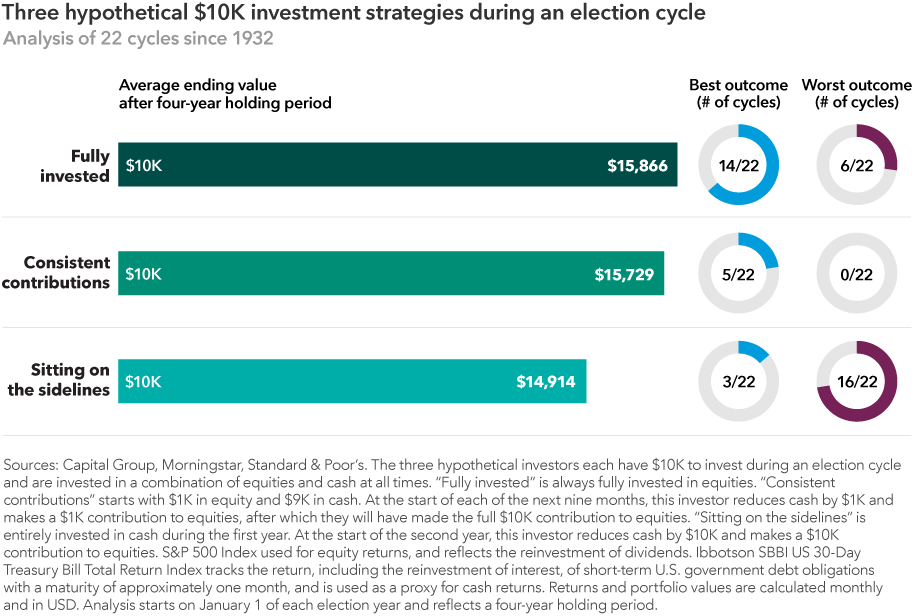
5. Moving to cash in election years can reduce long-term portfolio returns
What has been the best way to invest in election years? It isn’t by sitting on the sidelines.
To verify this, we looked at three hypothetical investors, each with a different investment approach. We then calculated the ending value of each of their portfolios over the last 23 election cycles, assuming a four-year holding period.
The investor who stayed on the sidelines had the worst outcome 17 times and had the best outcome only three times. Meanwhile, investors who were fully invested or made monthly contributions during election years came out on top. These investors had higher average portfolio balances over the full period and more frequently outpaced the investor who stayed in cash longer. These results reflect four-year holding periods, but the divergence would be even wider if compounded over longer time frames.
Sticking with a sound long-term investment plan based on individual investment objectives is usually the best course of action. Whether that strategy is to be fully invested throughout the year or to consistently invest through a vehicle such as a 401(k) plan, the bottom line is that investors should avoid market timing around politics. As is often the case with investing, the key is to put aside short-term noise and focus on long-term goals.
What does this mean for 2024? Cash investors have enjoyed their highest yields in decades, but those rates have paled in comparison to stock returns. Between October 2022 and June 2024 — a period in which money market fund assets increased from US$4.6 trillion to US$6.1 trillion — the S&P 500 Index rose more than 55%. It’s too early to know the long-term portfolio impact of this flight to cash, but it is safe to assume many investors missed at least some of this powerful equity rally and remain on the sidelines ahead of the November election.
©2024 Morningstar, Inc. All rights reserved. The information contained herein: (1) is proprietary to Morningstar and/or its content providers; (2) may not be copied or distributed; and (3) is not warranted to be accurate, complete or timely. Neither Morningstar nor its content providers are responsible for any damages or losses arising from any use of this information. Past performance is no guarantee of future results.
Our latest insights
-
-
-
U.S. Equities
-
Global Equities
-
Emerging Markets
Commissions, trailing commissions, management fees and expenses all may be associated with investments in investment funds. Please read the prospectus before investing. Investment funds are not guaranteed or covered by the Canada Deposit Insurance Corporation or by any other government deposit insurer. For investment funds other than money market funds, their values change frequently. For money market funds, there can be no assurances that the fund will be able to maintain its net asset value per security at a constant amount or that the full amount of your investment in the fund will be returned to you. Past performance may not be repeated.
Unless otherwise indicated, the investment professionals featured do not manage Capital Group‘s Canadian investment funds.
References to particular companies or securities, if any, are included for informational or illustrative purposes only and should not be considered as an endorsement by Capital Group. Views expressed regarding a particular company, security, industry or market sector should not be considered an indication of trading intent of any investment funds or current holdings of any investment funds. These views should not be considered as investment advice nor should they be considered a recommendation to buy or sell.
Statements attributed to an individual represent the opinions of that individual as of the date published and do not necessarily reflect the opinions of Capital Group or its affiliates. This information is intended to highlight issues and not be comprehensive or to provide advice. For informational purposes only; not intended to provide tax, legal or financial advice. Capital Group funds are available in Canada through registered dealers. For more information, please consult your financial and tax advisors for your individual situation.
Forward-looking statements are not guarantees of future performance, and actual events and results could differ materially from those expressed or implied in any forward-looking statements made herein. We encourage you to consider these and other factors carefully before making any investment decisions and we urge you to avoid placing undue reliance on forward-looking statements.
The S&P 500 Composite Index (“Index”) is a product of S&P Dow Jones Indices LLC and/or its affiliates and has been licensed for use by Capital Group. Copyright © 2025 S&P Dow Jones Indices LLC, a division of S&P Global, and/or its affiliates. All rights reserved. Redistribution or reproduction in whole or in part are prohibited without written permission of S&P Dow Jones Indices LLC.
FTSE source: London Stock Exchange Group plc and its group undertakings (collectively, the "LSE Group"). © LSE Group 2025. FTSE Russell is a trading name of certain of the LSE Group companies. "FTSE®" is a trade mark of the relevant LSE Group companies and is used by any other LSE Group company under licence. All rights in the FTSE Russell indices or data vest in the relevant LSE Group company which owns the index or the data. Neither LSE Group nor its licensors accept any liability for any errors or omissions in the indices or data and no party may rely on any indices or data contained in this communication. No further distribution of data from the LSE Group is permitted without the relevant LSE Group company's express written consent. The LSE Group does not promote, sponsor or endorse the content of this communication. The index is unmanaged and cannot be invested in directly.
BLOOMBERG® is a trademark and service mark of Bloomberg Finance L.P. and its affiliates (collectively “Bloomberg”). Bloomberg or Bloomberg’s licensors own all proprietary rights in the Bloomberg Indices. Neither Bloomberg nor Bloomberg’s licensors approves or endorses this material, or guarantees the accuracy or completeness of any information herein, or makes any warranty, express or implied, as to the results to be obtained therefrom and, to the maximum extent allowed by law, neither shall have any liability or responsibility for injury or damages arising in connection therewith.
MSCI does not approve, review or produce reports published on this site, makes no express or implied warranties or representations and is not liable whatsoever for any data represented. You may not redistribute MSCI data or use it as a basis for other indices or investment products.
Capital believes the software and information from FactSet to be reliable. However, Capital cannot be responsible for inaccuracies, incomplete information or updating of the information furnished by FactSet. The information provided in this report is meant to give you an approximate account of the fund/manager's characteristics for the specified date. This information is not indicative of future Capital investment decisions and is not used as part of our investment decision-making process.
Indices are unmanaged and cannot be invested in directly. Returns represent past performance, are not a guarantee of future performance, and are not indicative of any specific investment.
All Capital Group trademarks are owned by The Capital Group Companies, Inc. or an affiliated company in Canada, the U.S. and other countries. All other company names mentioned are the property of their respective companies.
Capital Group funds are offered in Canada by Capital International Asset Management (Canada), Inc., part of Capital Group, a global investment management firm originating in Los Angeles, California in 1931. Capital Group manages equity assets through three investment groups. These groups make investment and proxy voting decisions independently. Fixed income investment professionals provide fixed income research and investment management across the Capital organization; however, for securities with equity characteristics, they act solely on behalf of one of the three equity investment groups.
The Capital Group funds offered on this website are available only to Canadian residents.